
Concept explainers
(a)
Interpretation:
The
Concept introduction:
The compounds which have the same molecular formula but have different arrangements of atoms are known as isomers. The phenomenon is called isomerism. The isomers are generally classified as structural isomers and stereoisomers. Stereoisomers are further divided into two categories diastereomers and enantiomers.
Answer to Problem 9.44AP
The isomers of
Explanation of Solution
The structures of
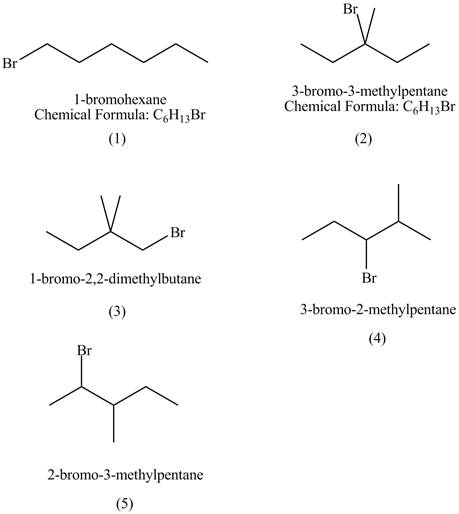
Figure 1
The compounds that have chiral centers can exist as enantiomers. The compound
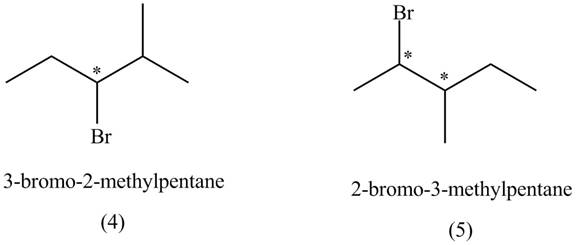
Figure 2
Therefore,
The compounds
(b)
Interpretation:
The alkyl halides among
Concept introduction:
The compounds which have the same molecular formula but have different arrangements of atoms are known as isomers. The phenomenon is called isomerism. The isomers are generally classified as structural isomers and stereoisomers. Stereoisomers are further divided into two categories diastereomers and enantiomers.
Answer to Problem 9.44AP
The isomer of
Explanation of Solution
The structures of
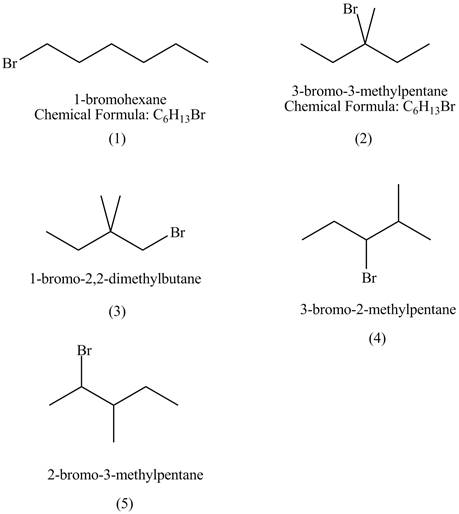
Figure 1
The compounds that have two chiral centers can exist as enantiomers. The compound
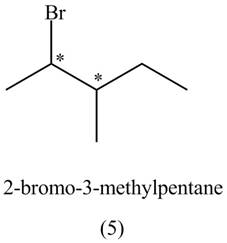
Figure 3
Therefore,
The compound
(c)
Interpretation:
The alkyl halides among
Concept introduction:
The replacement or substitution of one functional group with another different functional group in any chemical reaction is termed as a substitution reaction. In a nucleophilic substitution reaction, nucleophile takes the position of leaving the group by attacking on the electron-deficient carbon atom.
Answer to Problem 9.44AP
The fastest
Explanation of Solution
The structures of
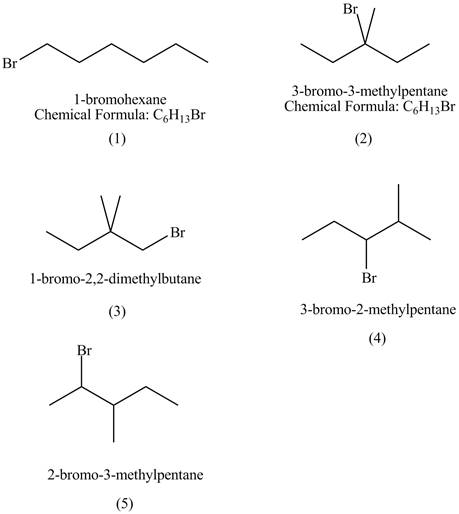
Figure 1
The rate of
The compound
The compound
(d)
Interpretation:
The alkyl halides among
Concept introduction:
The replacement or substitution of one
Answer to Problem 9.44AP
The isomer of
Explanation of Solution
The structures of

Figure 1
The compound
The compound,
(e)
Interpretation:
The alkyl halides among
Concept introduction:
The elimination reaction of alkyl halide involves removal of the halogen atom and hydrogen atom from the adjacent carbon atoms, which leads to the formation of the alkene. A bulky base increases the chance of elimination reaction of substitution reaction.
Answer to Problem 9.44AP
The compound
Explanation of Solution
The structures of
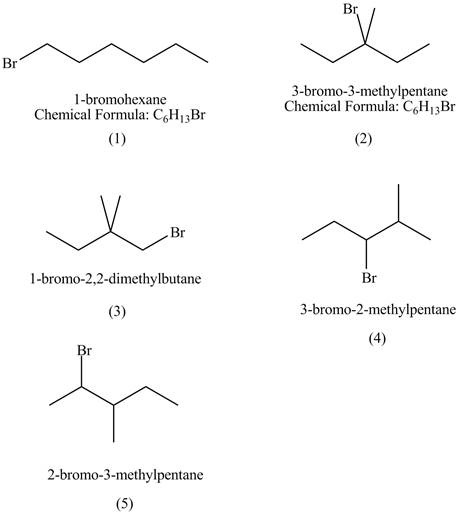
Figure 1
The compound
The
(f)
Interpretation:
The alkyl halides among
Concept introduction:
The replacement or substitution of one functional group with another different functional group in any chemical reaction is termed as a substitution reaction. In a nucleophilic substitution reaction, nucleophile takes the position of leaving the group by attacking on the electron-deficient carbon atom.
Answer to Problem 9.44AP
The alkyl halide among
Explanation of Solution
The structures of
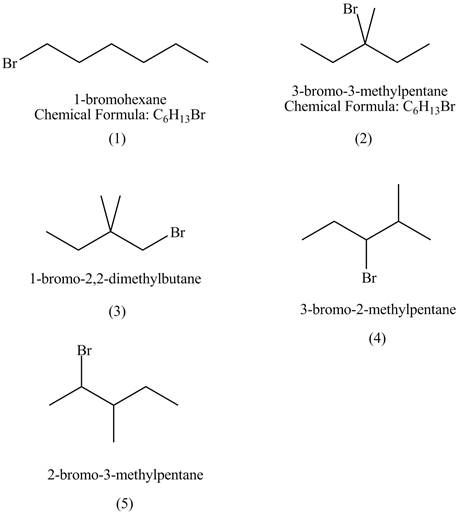
Figure 1
The rate of
The steric hindrance in case of
The isomer of
(g)
Interpretation:
The alkyl halides among
Concept introduction:
The replacement or substitution of one functional group with another different functional group in any chemical reaction is termed as a substitution reaction. In a nucleophilic substitution reaction, nucleophile takes the position of leaving the group by attacking on the electron-deficient carbon atom.
Answer to Problem 9.44AP
The alkyl halides among
Explanation of Solution
The structures of

Figure 1
The stability of tertiary carbocation is more than the stability of secondary carbocation. Therefore, in case of
The isomer of
(h)
Interpretation:
The alkyl halide among
Concept introduction:
The replacement or substitution of one functional group with another different functional group in any chemical reaction is termed as a substitution reaction. In a nucleophilic substitution reaction, nucleophile takes the position of leaving the group by attacking on the electron-deficient carbon atom.
Answer to Problem 9.44AP
The alkyl halide among
Explanation of Solution
The structures of

Figure 1
The rate of
Therefore,
The isomer of
Want to see more full solutions like this?
Chapter 9 Solutions
Organic Chemistry, Ebook And Single-course Homework Access
- Polymers may be composed of thousands of monomers. Draw three repeat units (trimer) of the polymer formed in this reaction. Assume there are hydrogen atoms there are hydrogen atoms on the two ends of the trimer. Ignore inorganic byproducts please.arrow_forwardi need help with the folarrow_forwardPLEASE HELP NOW! URGENT!arrow_forward
- a. Determine whether each of the Followery Molecules is in the R- On the y- Configuration 1-01"/ 1-6-4 Br 4 I el Br b. Draw The Fisher projection For all the Meso compounds that can exist FOR The Following molenlearrow_forward1- Refer to the monosaccharides below to answer each of the following question(s): CH₂OH CHO CH₂OH CH₂OH 0 H- OH 0 0 HO- H H- -OH HO H HO H H OH HO- H CH₂OH H. OH HO H HO- H CH₂OH CH₂OH CH3 a. Sorbose b. Rhamnose c. Erythrulose d. Xylulose Classify each sugar by type; for example, glucose is an aldohexose. a. Xylulose is .. b. Erythrulose is . c. Sorbose is .. d. Rhamnose is .. 2- Consider the reaction below to answer the following question(s). CHO H OH CH₂OH CH₂OH HO- H HO HO + H. -OH HO OH HO. H OH OH H -OH H OH CH₂OH Q Z a. Refer to Exhibit 25-11. Place a triangle around the anomeric carbon in compound Q. Compound Z is: b. 1. the D-anomer. 2. the a-anomer. 3. the ẞ-anomer. 4. the L-anomer. c. Which anomer is the LEAST stable? d. Q and Z are cyclic examples of: a. acetals b. hemiacetals c. alditols d. hemialditolsarrow_forwardi need help identifying the four carbon oxygen bonds in the following:arrow_forward
- Imagine each of the molecules shown below was found in an aqueous solution. Can you tell whether the solution is acidic, basic, or neutral? molecule HO H3N + The solution is... X O acidic OH O basic H3N-CH-C-O O neutral ○ (unknown) O acidic ○ basic CH2 CH 3-S-CH2 O neutral ○ (unknown) H3N O OH O acidic O basic Oneutral O (unknown) 0 H3N-CH-C-O CH3 CH CH3 O acidic O basic O neutral ○ (unknown) ? olo Ar BHarrow_forwardno Ai walkthroughs need other product (product in picture is wrong dont submit the same thing)arrow_forwardHow to solve this!arrow_forward
 Chemistry & Chemical ReactivityChemistryISBN:9781337399074Author:John C. Kotz, Paul M. Treichel, John Townsend, David TreichelPublisher:Cengage Learning
Chemistry & Chemical ReactivityChemistryISBN:9781337399074Author:John C. Kotz, Paul M. Treichel, John Townsend, David TreichelPublisher:Cengage Learning Chemistry & Chemical ReactivityChemistryISBN:9781133949640Author:John C. Kotz, Paul M. Treichel, John Townsend, David TreichelPublisher:Cengage Learning
Chemistry & Chemical ReactivityChemistryISBN:9781133949640Author:John C. Kotz, Paul M. Treichel, John Townsend, David TreichelPublisher:Cengage Learning Introduction to General, Organic and BiochemistryChemistryISBN:9781285869759Author:Frederick A. Bettelheim, William H. Brown, Mary K. Campbell, Shawn O. Farrell, Omar TorresPublisher:Cengage Learning
Introduction to General, Organic and BiochemistryChemistryISBN:9781285869759Author:Frederick A. Bettelheim, William H. Brown, Mary K. Campbell, Shawn O. Farrell, Omar TorresPublisher:Cengage Learning


